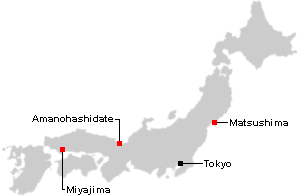
Miyajima

Miyajima

Miyajima

Miyajima
Miyajima
AFTER SNOWFALL -- Hiroshima has little snow in the southern areas along the Seto Inland Sea while there are several good snowboarding resorts in the mountain. If you are lucky, you can see the beauty of Miyajima enhanced by snowfall.
TORII RENOVATION WORK COMPLETED -- After three and a half years of the renovation work, the torii revealed its magnificent figure at the end of 2022. Before removing the last temporary working stage, the special exhibition was held for us to closely look at the largest wooden torii in Japan.
FLOATING SHRINE -- Itsukushima Shrine in Miyajima is known as a floating shrine. There are not many chances to see it, though. Your visit timing needs to coincide with both spring and high tides. It is good to check on them before your visit. It looks really floating.
SAKURA SEASON -- Miyajima is one of the most famous Sakura viewing spots in Hiroshima. It blooms late March and ends early April. All the shrines, temples and wild deer blended into the nature look gorgeous and beautifu.
MIYAJIMA IS A SACRED ISLAND -- Our ancient people living across from Miyajima used to put their hands together, as a sign of respect toward this island. Why is the island called "God Island"? The mountain behind Itsukushima Shrine surely looks like Kannon Bosatsu, the Deity of Mercy. There are many interesting stories hidden in the sacredness. Come on and find them!
THREE MOST SCENIC SPOTS IN JAPAN (NIHON-SANKEI) -- Miyajima has been called as one of the Three Most Scenic Spots in Japan for hundreds of years. It is said that you should visit them once in your lifetime. Other two are Amanohashidate (the ladder to the heaven) in Kyoto and Matsushima (Pine Island) in Miyagi. They are characterized by the abundant greeneries and beautiful sea.
There are many new "Best Place to visit" articles featured by travel magazines, but the Japan's Three Most Scenic Places are the most famous and historically valuable title in Japan's tourism.
For more information, please visit the following links:
Japan-guide.com
Nihon-sankei homepage

ITSUKUSHIMA SHRINE AND THE TORII GATE -- All visitors are impressed with the beauty of the Shrine and the Torii Gate. The illumination at sunset further adds its profoundness. Wild deer, the symbol of Miyajima, welcome you. Everything is simply beautiful on this island.
There are many interesting things you can enjoy on the way to and within Itsukushima Shrine.






DAISHOIN TEMPLE -- This temple has a solemn atmosphere with 1,200 years of history and is known as a strong power spot (i.e., spiritual zone). This temple has a lot of mysterious things that tourists can not find without guide.
They run "walk on fire" rituals in both the spring and autumn. Please see the "Events in Hiroshima" tab for more details.
(Click here for Daishoin Temple official youtube channel).




Mt. Misen Climbing
The locations shown below can be visited only when you climb up Mt. Misen which is available in parallel with the Peace Memorial Park and Miyajima Tour.
ETERNAL FLAME AND OGRES AT MT. MISEN -- The eternal fire has been burning for 1,200 years at Reikado Hall. Three ogres are enshrined at Sankido Hall. (Click here for Mt. Misen official youtube channel)

Eternal Flame at Reikado Hall

Sankido Hall
MYSTERIOUS STONES ON TOP -- As you go closer to the top, you'll encounter the gigantic stones. Who brought them up to the top? Gods or aliens?


THREE STARS OF MICHELIN GREEN GUIDE -- The beautiful views from the Misen observatory is granted the highest rank of three stars in Michelin Green Guide, meaning a beautiful spot to visit. Come and enjoy the scenery!

Our tours entertain you with in-depth explanations using illustrations. It will answer many of your questions, including explanations of the unique Japanese cultural differences.